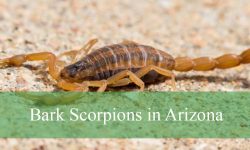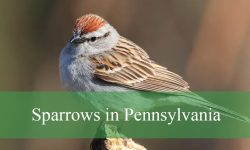Hummingbirds in Ohio are among the most fascinating birds to observe, with their dazzling colors, lightning-fast movements, and remarkable hovering abilities. Although only one species breeds regularly in the state, several other types pass through during migration or show up as rare visitors. Spotting and identifying these tiny creatures has become a favorite activity for bird lovers across Ohio.
This article highlights 8 types of hummingbirds in Ohio, complete with pictures and identification tips to help you recognize each one. From the familiar Ruby-throated Hummingbird to unexpected guests like the Broad-billed and Mexican Violetear, each species has its own story and seasonal pattern in the region. Knowing when and where to look increases your chances of witnessing these beautiful birds firsthand.
Learning more about the different types of hummingbirds in Ohio not only adds excitement to backyard birdwatching but also deepens appreciation for the diversity of wildlife in the state. With the right feeder setup and a keen eye, anyone can enjoy the magic of hummingbirds in Ohio throughout the year.
Different Types of Hummingbirds in Ohio
Ruby-throated Hummingbird (Archilochus colubris)
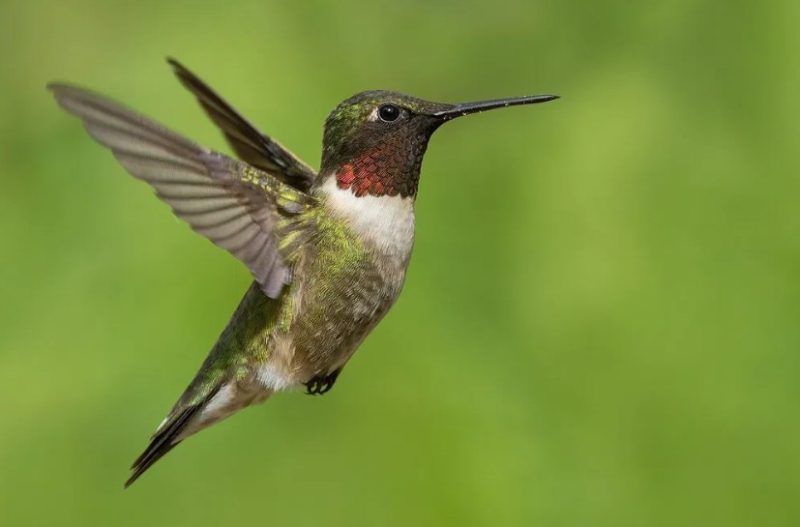
The Ruby-throated Hummingbird is the most familiar and widespread hummingbird species in Ohio. Males are easily recognized by their iridescent ruby-red throats, metallic green backs, and white underparts, while females lack the red throat and display a more subdued green and white plumage. These birds are tiny, measuring about 3 to 3.5 inches long, with fast-beating wings that allow them to hover effortlessly as they feed on nectar. Their slender, slightly curved bills are perfectly adapted for reaching deep into flowers, and their incredible agility in flight makes them a captivating sight in gardens and woodlands across the state.
Ruby-throated Hummingbirds migrate to Ohio from their wintering grounds in Central America, usually arriving in late April and staying through September. They are found throughout the state, especially in suburban yards, forest edges, meadows, and areas with flowering plants. They prefer habitats that offer abundant nectar sources, such as trumpet vine, bee balm, and cardinal flower, as well as access to small insects for protein. These hummingbirds are highly territorial, often engaging in aerial chases to defend feeding areas or nesting territories from other hummingbirds.
In Ohio, Ruby-throated Hummingbirds are the only species known to breed regularly. They build cup-shaped nests out of plant down and spider silk, usually placed on slender tree branches. The female alone incubates the eggs and feeds the young. These birds feed primarily on flower nectar but will also visit hummingbird feeders filled with a sugar-water solution. Insects and spiders are also an essential part of their diet, especially during the breeding season. Their presence is a welcome sign of spring and summer for many Ohio birdwatchers.
Rufous Hummingbird (Selasphorus rufus)
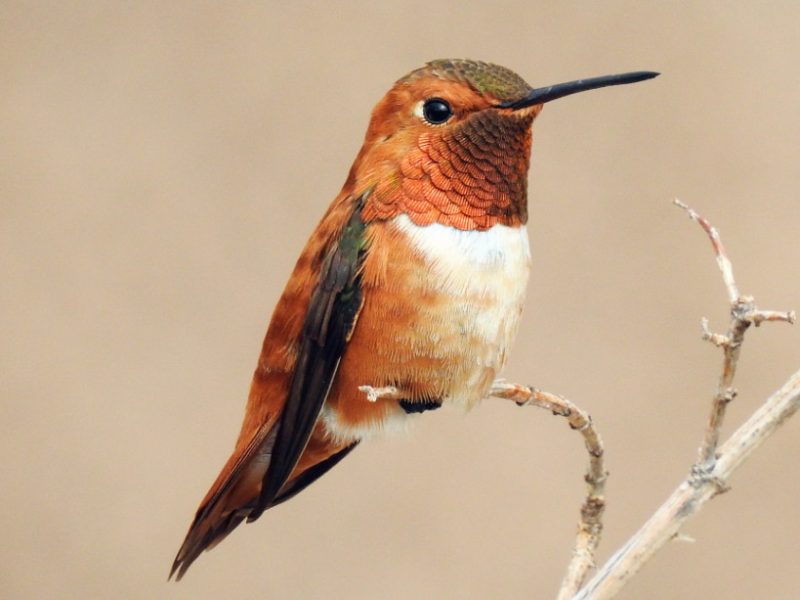
The Rufous Hummingbird is known for its fiery orange coloration and tenacious behavior. Males display a bright rufous back and belly with an iridescent red-orange throat, while females are greenish above with rufous-washed sides and a spotted throat. Slightly smaller than the Ruby-throated, they measure about 3 inches in length and are often noted for their boldness and aggression, even toward larger birds. Their wingbeats are rapid, and their sharp, buzzy calls can help distinguish them from other hummingbirds during brief visits.
Although they breed primarily in the Pacific Northwest and Alaska, Rufous Hummingbirds are long-distance migrants and are occasionally seen in Ohio, especially during fall and winter. Their presence in the state is considered rare but has become more frequently documented in recent decades due to the increased use of hummingbird feeders and interest in winter hummingbird monitoring. Sightings are typically in southern Ohio and near urban gardens or wooded areas where feeders are maintained through the colder months.
Rufous Hummingbirds feed on nectar from tubular flowers and are particularly drawn to red or orange blooms. In Ohio, they are most often seen at feeders offering a 4:1 sugar-to-water solution, especially from October through December. They also consume small insects and spiders for protein. These hummingbirds are extremely territorial, often chasing away other birds from feeders even when they’re far from their usual range. Their remarkable migration route, which can span over 3,000 miles, continues to intrigue researchers and bird enthusiasts alike.
Black-chinned Hummingbird (Archilochus alexandri)
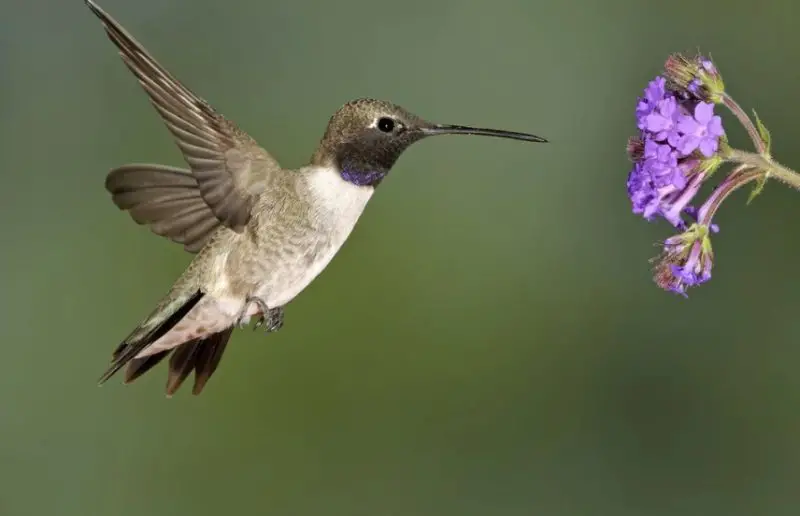
The Black-chinned Hummingbird is a rare visitor to Ohio and is more commonly found in the western United States. Males have a dark, iridescent purple throat band that appears black in poor lighting, along with a metallic green back and grayish-white underparts. Females lack the colored throat and are less vibrant overall but share the same small, sleek body shape. At about 3.25 inches long, they are similar in size to the Ruby-throated Hummingbird but are best distinguished by their subtle coloration and vocalizations.
In Ohio, sightings of Black-chinned Hummingbirds are extremely rare and typically occur during spring or fall migration. Their natural range extends from the southwestern U.S. to the Pacific coast, and their appearance in Ohio is usually due to wandering or misdirected individuals. Most reports in the state come from areas with active birding communities and consistent feeder maintenance, such as in southern or central Ohio. They are not known to breed in the state, and their visits are brief and sporadic.
Black-chinned Hummingbirds feed on nectar from a wide variety of flowering plants and will readily use feeders. They are also known to consume small insects, especially during breeding. In their typical habitat out west, they favor desert scrub, riparian corridors, and urban areas with flowering vegetation. In Ohio, their temporary habitats often include gardens and forest edges. Though uncommon, their occasional appearance excites local birders and highlights the value of keeping feeders up during migration seasons.
Calliope Hummingbird (Selasphorus calliope)
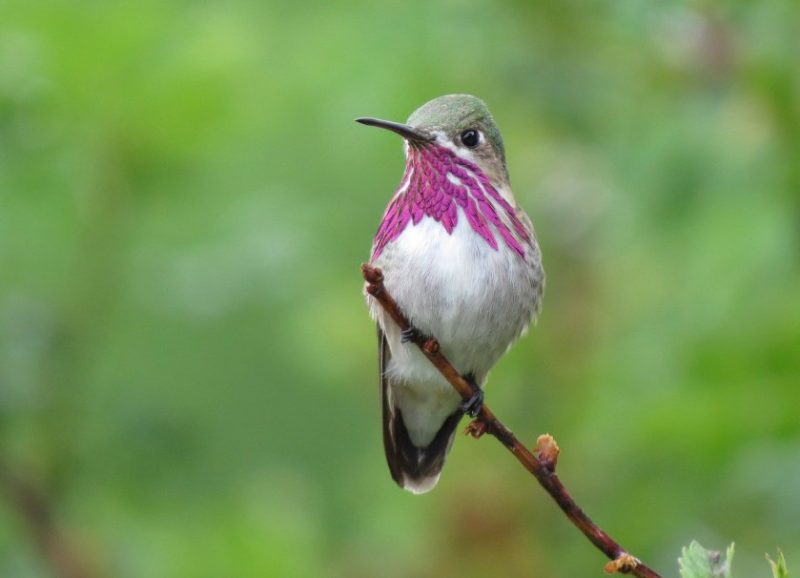
The Calliope Hummingbird is the smallest bird regularly found in the United States, measuring just 2.75 to 3 inches long. Males are especially striking with their iridescent magenta throat feathers, which are elongated and form a spiky, fan-like pattern. Females are more subtly colored, with green backs and pale underparts, often with faint streaking on the throat. Despite their tiny size, Calliope Hummingbirds are known for their remarkable stamina and long migration journeys.
Though their breeding range is restricted to the mountainous western U.S., Calliope Hummingbirds have been occasionally spotted in Ohio, particularly during fall migration. These rare sightings generally occur between September and November and are typically documented by experienced birders who maintain feeders and submit reports to state birding records. Their appearances are considered noteworthy events in the Ohio birding community due to their diminutive size and unique appearance.
Calliope Hummingbirds rely heavily on nectar from flowering plants and supplemental food sources like hummingbird feeders during their migration. They also eat small insects for protein. Their preferred habitats include meadows, forest edges, and shrubby areas, though in Ohio, they are usually seen in backyards or protected natural areas during brief stopovers. While not a regular visitor, their occasional presence in the state demonstrates the importance of monitoring migration and maintaining nectar sources late into the fall.
Anna’s Hummingbird (Calypte anna)
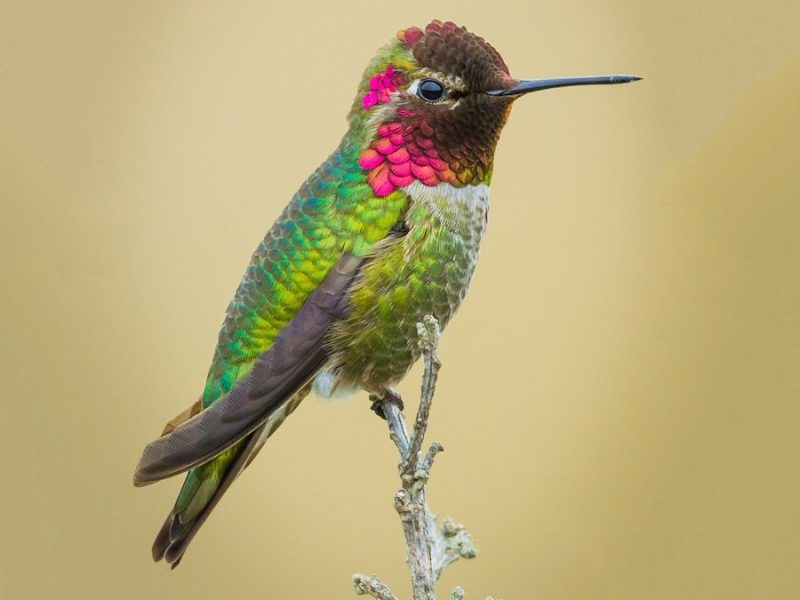
Anna’s Hummingbird is a vibrant and hardy species native to the western United States, especially abundant along the Pacific Coast in California. Males are known for their striking iridescent rose-pink throat and crown, which can glow brilliantly in sunlight. Females are more subdued with green backs and grayish underparts, lacking the vivid crown coloration. Slightly larger than the Ruby-throated Hummingbird, Anna’s measure around 4 inches in length and are well-adapted to various environments, including urban gardens and coastal scrub.
Although Anna’s Hummingbird is not native to the Midwest, it has occasionally appeared in Ohio, most often during the colder months from late fall to early winter. These rare vagrants may be drawn to backyard feeders that are maintained year-round or linger due to changes in migratory behavior. Sightings are scattered and infrequent, but their presence has increased slightly in recent years due to expanding range and the species’ notable adaptability to colder climates.
In their typical habitat, Anna’s Hummingbirds feed on nectar from a variety of flowering plants and also catch small insects mid-air. In Ohio, when present, they are often observed frequenting sugar-water feeders and blooming winter garden plants like salvia or late-season honeysuckle. Their ability to survive in cooler temperatures sets them apart from most other hummingbird species, making any appearance in Ohio a special occasion for birders.
Allen’s Hummingbird (Selasphorus sasin)

Allen’s Hummingbird is a very rare visitor to Ohio and is commonly mistaken for the Rufous Hummingbird due to its similar appearance. Males display a bright coppery-orange back and sides with a glittering orange-red throat, while females have green backs and pale bellies with hints of rust on their flanks. This species is compact and agile, measuring about 3 to 3.5 inches in length, and shares the energetic flight style typical of hummingbirds.
Native to coastal California and parts of southern Oregon, Allen’s Hummingbird is not expected in Ohio, and its occasional appearances are typically recorded during fall or early winter. Correct identification is crucial, as separating Allen’s from Rufous Hummingbirds often requires close observation or even banding and DNA analysis. Only a small number of confirmed sightings exist in Ohio, often involving detailed reports by hummingbird experts or ornithologists.
Allen’s Hummingbirds feed on nectar from native tubular flowers and are especially attracted to red blooms like fuchsia and coral honeysuckle. In Ohio, they may visit hummingbird feeders maintained through the fall or found in gardens with appropriate late-season flowers. They also supplement their diet with small insects. Despite being nearly indistinguishable from the Rufous in the field, the presence of Allen’s Hummingbird in Ohio remains a noteworthy event for serious birders and banding programs.
Mexican Violetear (Colibri thalassinus)
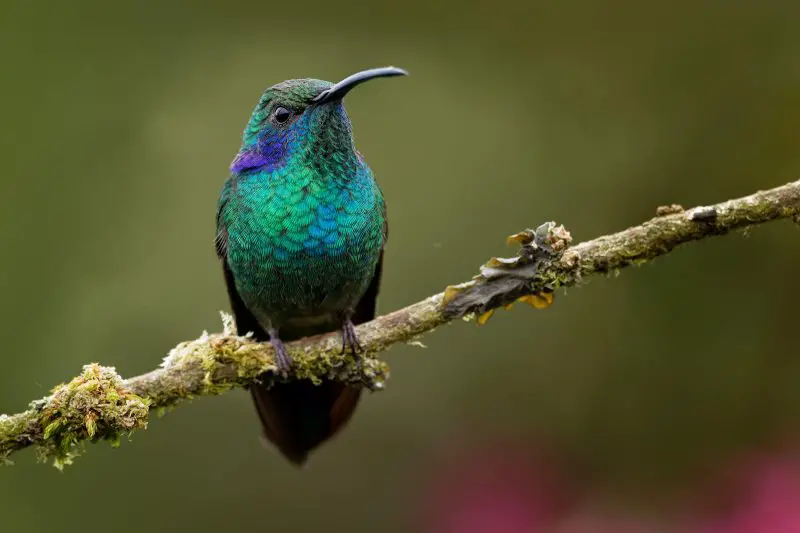
The Mexican Violetear is a medium-sized hummingbird known for its dazzling green plumage and prominent violet patches on the sides of its head. Native to the highland forests of Mexico and Central America, this species measures about 4.5 inches in length and has a distinctive, metallic appearance that sets it apart from North America’s smaller hummingbirds. Males and females are similar in appearance, both shimmering with iridescent greens and blues in natural light.
This tropical species is an extremely rare and irregular visitor to Ohio. When it does appear, it is typically during summer or early fall and is considered a casual wanderer far outside its normal range. Only a handful of confirmed sightings have been recorded in the state, often at well-maintained backyard feeders or near flowering gardens. These individuals are believed to be wandering migrants, possibly disoriented during dispersal.
In its native range, the Mexican Violetear frequents cloud forests and edges of woodlands, feeding on nectar from tropical flowers and also capturing flying insects. In Ohio, it typically visits hummingbird feeders offering a sugar-water solution and may remain in the area for several days if conditions are favorable. Due to its rarity and brilliant coloration, any appearance of the Mexican Violetear generates significant excitement among birdwatchers in the region.
Broad-billed Hummingbird (Cynanthus latirostris)
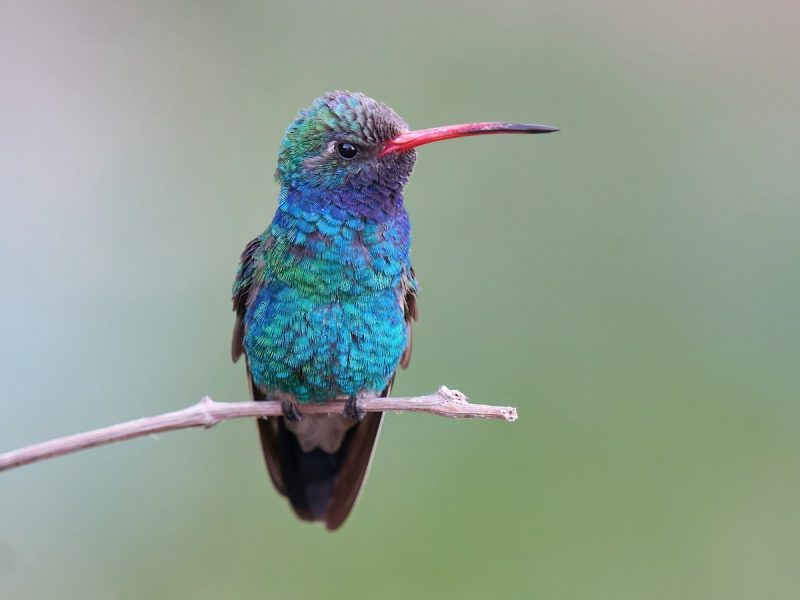
The Broad-billed Hummingbird is one of the most vividly colored hummingbirds in North America, with adult males displaying a glittering blue-green body and a bold, reddish-orange bill tipped with black. Females are more muted in appearance, with grayish underparts and a straighter, less colorful bill. Measuring around 3.5 to 4 inches in length, this species is easily recognized in its native habitat, which spans from southwestern U.S. deserts into Mexico.
This species is the rarest of all hummingbirds recorded in Ohio, with only one or a few confirmed sightings. These out-of-range appearances are considered exceptional and usually occur in late fall, often when a lone individual becomes disoriented during migration. The Broad-billed Hummingbird’s usual range does not extend east of Texas and Arizona, making any report in the Midwest particularly noteworthy.
Broad-billed Hummingbirds prefer arid scrublands, canyons, and desert gardens with flowering plants like agave and ocotillo. When they turn up in Ohio, they are typically found at backyard feeders stocked with sugar water and surrounded by late-season flowers. Their brief and rare appearances are prized by birders and often documented extensively through photos and reports. Despite their rarity, they are a reminder of how unpredictable and adventurous hummingbird migrations can be.

